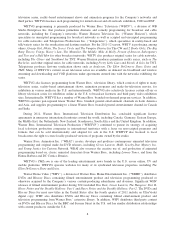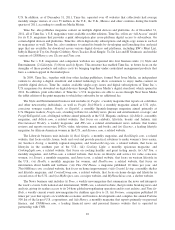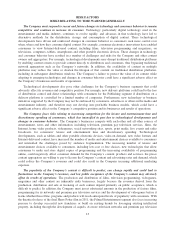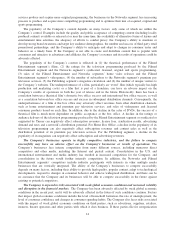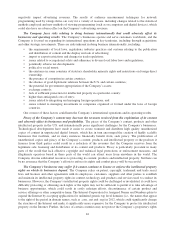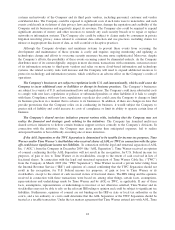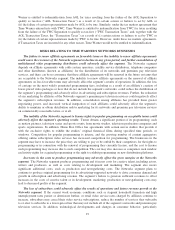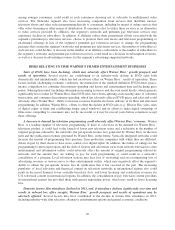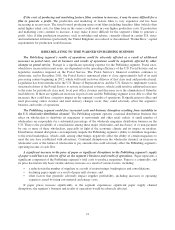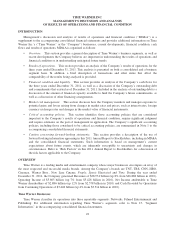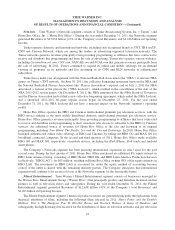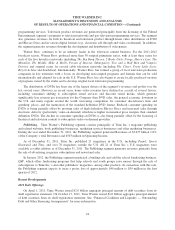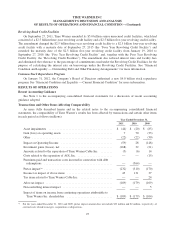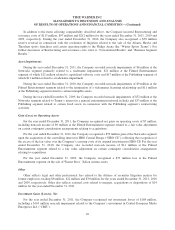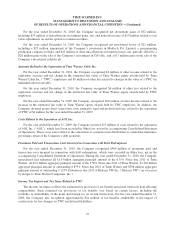Time Magazine 2011 Annual Report Download - page 31
Download and view the complete annual report
Please find page 31 of the 2011 Time Magazine annual report below. You can navigate through the pages in the report by either clicking on the pages listed below, or by using the keyword search tool below to find specific information within the annual report.or such laws may not be strictly enforced, and the Company may be unable to protect its intellectual property
adequately against unauthorized copying or use in certain countries. In addition, there are legislative and
regulatory efforts under review in certain international territories, which, if successful, could reduce the
protection for the Company’s intellectual property and limit its ability to license its content.
The Company has been, and may be in the future, subject to claims of intellectual property infringement,
which could have an adverse impact on the Company’s businesses or operating results. Successful challenges
to the Company’s intellectual property could require the Company to enter into royalty or licensing agreements
on unfavorable terms, incur substantial monetary liability or be enjoined preliminarily or permanently from
further use of the intellectual property in question. This could require the Company to change its business
practices and limit its ability to compete effectively. If the Company is required to take any of these actions, it
could have an adverse impact on the Company’s businesses or operating results. Even if the Company believes
that the claims of intellectual property infringement are without merit, defending against the claims can be time-
consuming and costly and divert management’s attention and resources away from its businesses.
The Company’s businesses are subject to labor interruption. The Company and certain of its suppliers
retain the services of writers, directors, actors, athletes, technicians, trade employees and others involved in the
development and production of motion pictures, television and digital programming and magazines who are
covered by collective bargaining agreements. The collective bargaining agreements with the International
Alliance of Theatrical Stage Employees, The International Brotherhood of Teamsters and other trade unions,
which represent people involved in the production of theatrical films and television programs, expire on July 31,
2012. If the Company or its suppliers are unable to renew expiring collective bargaining agreements, it is
possible that the affected unions could take actions in the form of strikes, work slowdowns or work stoppages.
Strikes, work slowdowns or work stoppages or the possibility of such actions and attempts to unionize, could
cause delays in the production or the release dates of the Company’s feature films, television programming and
magazines. The Company could also incur higher costs from such actions, new collective bargaining agreements
or the renewal of collective bargaining agreements on less favorable terms. Many of the Company’s collective
bargaining agreements are industry-wide agreements, and the Company may lack practical control over the
negotiations and terms of these agreements. Union or labor disputes or player lock-outs relating to professional
sports leagues for which the Networks segment has the rights to produce and telecast live games or events may
preclude the Networks segment from telecasting scheduled games or events, which could have a negative impact
on the Networks segment’s subscription and advertising revenues. Further, the loss of television programming
due to such disputes could negatively impact the segment’s promotional and marketing opportunities. Depending
on its duration, a labor dispute could have an adverse effect on the Company’s businesses or results of
operations.
The Company’s businesses rely heavily on information technology networks, systems and other
technology, and a disruption or failure of such networks, systems or technology as a result of computer
viruses, misappropriation of data or other malfeasance, as well as outages, natural disasters, accidental
releases of information or similar events, may disrupt the Company’s businesses, damage its reputation or
have a negative impact on its revenues. Because network and information systems and other technologies are
critical to many of the Company’s operating activities, network or information system shutdowns or service
disruptions at the Company or vendors that provide systems or services to the Company pose increasing risks.
Such disruptions may be caused by events such as computer hacking, dissemination of computer viruses, worms
and other destructive or disruptive software, denial of service attacks and other malicious activity, as well as
power outages, natural disasters (including extreme weather), failures or impairments of communications
satellites or on ground uplinks or downlinks used to transmit programming, terrorist attacks and similar events.
Such events could have an adverse impact on the Company and its customers, including degradation or
disruption of service and damage to equipment and data. Significant incidents could result in a disruption of the
Company’s operations, customer or advertiser dissatisfaction, damage to the Company’s reputation or a loss of
customers or revenues. Currently, there are a limited number of communications satellites available for the
transmission of programming.
The Company and its businesses also could be subject to risks caused by misappropriation, misuse, leakage,
falsification or intentional or accidental release or loss of information maintained in the information technology
17



